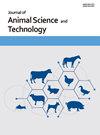益生菌对大肠杆菌和肠炎沙门氏菌攻毒断奶仔猪生长性能、肠道形态和肠道菌群的影响
IF 3.2
3区 农林科学
Q1 AGRICULTURE, DAIRY & ANIMAL SCIENCE
引用次数: 0
摘要
本研究旨在评价单株和多株乳酸菌对感染或未感染大肠杆菌(e.c oli)的断奶仔猪生长性能、营养物质消化率、血液特征、粪便有害气体排放、肠道微生物群和肠道形态的影响。和<斜体>肠沙门氏菌(</斜体>SE<斜体>)</斜体>。试验1,将60头杂交断奶仔猪随机分为5种饲粮处理。饲粮处理包括:阴性对照;基础日粮中不添加任何添加物)、PC(阳性对照;基础日粮中添加0.01%的植物乳杆菌</italic>(LP),含1.0 × 10< supit>8</ supit>CFU/g)、K(基础饲粮中添加0.1% <italic>K (K)包含1.0 × 10<sup>9</sup>CFU/g)、WK1(基础饲粮中添加0.1% <italic> /italic>SMFM2016-WK1 (WK1)含1.0 × 10<sup>9</sup>CFU/g)、K-WK1(基础日粮中添加0.05% K + 0.05% WK1,含1.0 × 10<sup>9</sup>CFU / g)。K组平均日增重(ADG)高于WK1组。K-WK1组腹泻评分低于NC组。在属水平上,<italic>Roseburia</italic>WK1丰度高于其他治疗组。在物种水平上,<斜体>蓝杉属的物种数量较少</斜体>WK1的丰度低于其他组,而[lt;italic>葡聚糖溶剂琥珀弧菌]lt;/italic>WK1的丰度较高。PC组和WK1组血清促炎细胞因子水平均低于NC组。试验2采用2 × 5因子安排,包括两个激射水平(激射和非激射),并以<斜体>E表示。coli< / italic>和SE和5个水平的益生菌与Exp.1相同。与其他组相比,添加LP和WK1组的平均日增重更高,腹泻评分更低。因此,在口服激发试验和饲养试验中,添加WK1对仔猪的生长性能、腹泻、绒毛高度和肠道微生物群均有显著的促进作用。因此,在本实验中使用的益生菌中,WK1可能是最有效的。本文章由计算机程序翻译,如有差异,请以英文原文为准。
Effects of probiotics on growth performance, intestinal morphology, intestinal microbiota weaning pig challenged with Escherichia coli and Salmonella enterica
This study aimed to evaluate the effects of mono- and multi-strain LAB probiotics on the growth performance, nutrient digestibility, blood profiles, fecal noxious gas emission, intestinal microbiota and intestinal morphology of weaning pigs challenged with or without Escherichia coli (E. coli) and Salmonella enterica ( SE) . In Exp. 1, a total of 60 crossbred weaning pigs were randomly allotted to one of five dietary treatments. The dietary treatments included: NC (negative control; basal diet with no supplement), PC (positive control; basal diet with 0.01% Lactiplantibacillus plantarum (LP) containing 1.0 × 108 CFU/g), K (basal diet with 0.1% Pediococcus acidilactici K (K) containing 1.0 × 109 CFU/g), WK1 (basal diet with 0.1% Pediococcus pentosaceus SMFM2016-WK1 (WK1) containing 1.0 × 109 CFU/g), K-WK1 (basal diet with 0.05% K + 0.05% WK1 containing 1.0 × 109 CFU/g). The average daily gain (ADG) was higher in the K group than in the WK1 group. Diarrhea score was lower in the K-WK1 group than in the NC group. At the genus level, Roseburia abundance in WK1 was higher than in the other treatment groups. At the species level, Blautia wexlerae abundance was lower in WK1 than in the other groups, whereas Succinivibrio dextrinosolvens abundance was higher in WK1. The serum pro-inflammatory cytokine levels in the PC and WK1 groups were as low as those in the NC group. Experiment 2 was conducted with two trials in a 2 × 5 factorial arrangement of treatments consisting of two levels of challenge (challenge and non-challenge) with E. coli and SE and five levels of probiotics same as Exp.1. Supplementation with LP and WK1 resulted in higher ADG and lower diarrhea scores than those in the other groups. Consequently, supplementation of WK1 showed a particularly positive effect on growth performance and diarrhea, villus height and intestinal microbiota in oral challenge experiment and feeding trial. Therefore, WK1 might be the most effective among the probiotics used in this experiment.
求助全文
通过发布文献求助,成功后即可免费获取论文全文。
去求助
来源期刊

Journal of Animal Science and Technology
Agricultural and Biological Sciences-Food Science
CiteScore
4.50
自引率
8.70%
发文量
96
审稿时长
7 weeks
期刊介绍:
Journal of Animal Science and Technology (J. Anim. Sci. Technol. or JAST) is a peer-reviewed, open access journal publishing original research, review articles and notes in all fields of animal science.
Topics covered by the journal include: genetics and breeding, physiology, nutrition of monogastric animals, nutrition of ruminants, animal products (milk, meat, eggs and their by-products) and their processing, grasslands and roughages, livestock environment, animal biotechnology, animal behavior and welfare.
Articles generally report research involving beef cattle, dairy cattle, pigs, companion animals, goats, horses, and sheep. However, studies involving other farm animals, aquatic and wildlife species, and laboratory animal species that address fundamental questions related to livestock and companion animal biology will also be considered for publication.
The Journal of Animal Science and Technology (J. Anim. Technol. or JAST) has been the official journal of The Korean Society of Animal Science and Technology (KSAST) since 2000, formerly known as The Korean Journal of Animal Sciences (launched in 1956).
 求助内容:
求助内容: 应助结果提醒方式:
应助结果提醒方式:


